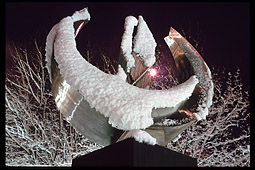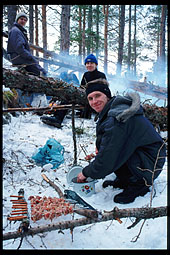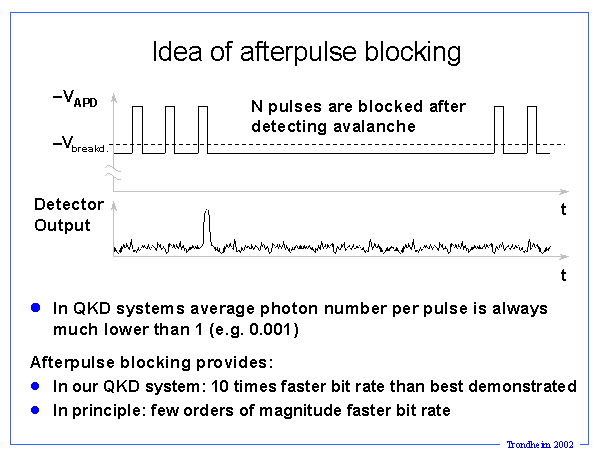

|
High-speed single photon detector for quantum cryptosystemsa master thesis done in Quantum Cryptography Project at the Department of Electronics and Telecommunications |
| Student: |
Kirill Vylegjanine,
vylegjanine@reksoft.ru (exchange student from Radiophysics Department, St. Petersburg State Technical University) |
| Supervisor (Norway): | Professor Dag Roar Hjelme |
| Supervisor (Russia): | Andrei Medvedev, medvedev@radio.rphf.spbstu.ru |
| Delivered: | June 2000 (stay in Norway and experimental work took place in spring term of 1999) |
This thesis introduced the concept and reported the first demonstration1 of afterpulse blocking2 technique, which practically eliminates afterpulsing effect in Geiger-mode APD-based single photon detectors. In quantum key distribution (QKD) systems, it allows for much higher bit rates without introducing additional errors.
This work improved the basic single-photon detector developed in Torbjoern Nesheim's thesis.
 The thesis is written in Russian only. It's available in two formats:
The thesis is written in Russian only. It's available in two formats:
These dark counts are indistinguishable from counts caused by real photons. They result in detection errors. The fraction of errors quickly rises if you try to increase the rate at which you arm the detector. In QKD systems operating at 1300nm and 1550nm, this limits the pulse rate to few MHz at best, restricting the key generation rate to meagre several Kbit per second.
To get around this limit, we proposed to block certain number of gate pulses after each avalanche, giving the trapped carriers time to dissipate.

This simple idea allows for significantly greater key generation rates with today's APDs. The probability to detect a photon in a real QKD system is very low, and the detector is still armed most of the time, even though you block several pulses after each avalanche.
Kirill's thesis describes a hardware implementation of afterpulse blocking
(for those interested, detailed schematics of the electronics can be found on
Actually, if your pulse rate is not very high and doesn't cause sustaining avalanches in many pulses in a row, you can probably get away with purely software-based implementation. Then you don't have to block the gate pulses, but should discard all detection events within a set number of bit slots after the first detection event. This seem to work with our 20 MHz detector.
1The idea of afterpulse blocking was disseminated at the 1st QIPC Workshop in Potsdam, September 27-29, 2000 (Vadim Makarov presented a poster there). It is widely used now. Since we have not published a paper on afterpulse blocking, we don't always get credited for it :)
Of course it should be pointed out that hold-off time was used to reduce afterpulsing effect in continuous mode APD operation by the group at Politecnico di Milano as early as in 1992. We just married hold-off time with gated operation.
2The term afterpulse blocking was coined later (probably by Dr. Jason Smith from Heriot-Watt University who used it in his photoluminescence microscope). We called this technique gate pulse blocking when Kirill worked on his thesis.